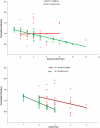Dopamine Transporter SPECT Imaging in Corticobasal Syndrome
- PMID: 21559307
- PMCID: PMC3085517
- DOI: 10.1371/journal.pone.0018301
Dopamine Transporter SPECT Imaging in Corticobasal Syndrome
Abstract
Objective: To investigate dopaminergic function in a large cohort of patients with corticobasal syndrome (CBS) and describe its relationship with clinical features in comparison to Parkinson's disease and healthy control subjects. In addition, we assessed prevalence and features of individuals with CBS and in vivo evidence of preserved nigral neuronal density.
Background: Substantia nigra pars compacta (SNc) neuronal degeneration is a mandatory pathological criterion for definite corticobasal degeneration, though sporadic autopsy-proven cases with ante-mortem imaging evidence of preserved nigral terminals have been recently described.
Methods: In this multicenter study, we investigated presynaptic nigrostriatal function in 36 outpatients fulfilling clinical criteria for "probable corticobasal degeneration" (age 71±7.3 years; disease duration 3.9±1.6 years), 37 PD and 24 healthy control subjects using FP-CIT single photon emission computed tomography. Clinical, neuropsychological, and magnetic resonance imaging assessment was performed to characterize CBS patients. Linear discriminant analysis was used to categorize normal vs. pathological scans.
Results: FP-CIT binding reduction in patients with CBS was characterized by larger variability, more uniform reduction throughout the striatum and greater hemispheric asymmetry compared to PD. Moreover, there was no significant correlation between tracer uptake values and clinical features such as disease duration and severity. Despite all CBS subjects showed obvious bilateral extrapyramidal signs, FP-CIT uptake was found to be normal bilaterally in four CBS patients and only unilaterally in other four cases. Extensive clinical, neuropsychological and imaging assessment did not reveal remarkable differences between CBS subjects with normal vs. pathological FP-CIT uptake.
Conclusions: Our findings support the hypothesis that extrapyramidal motor symptoms in CBS are not invariably associated with SNc neuronal degeneration and that supranigral factors may play a major role in several cases. CBS individuals with normal FP-CIT uptake do not show any clinical or cognitive feature suggesting a different pathology than CBD.
Conflict of interest statement
Figures



References
-
- Mahapatra RK, Edwards MJ, Schott JM, Bhatia KP. Corticobasal degeneration. Lancet Neurol. 2004;3:736–743. - PubMed
-
- Lang AE, Bergeron C, Pollanen MS, Ashby P. Parietal Pick's disease mimicking cortical-basal ganglionic degeneration. Neurology. 1994;44(8):1436–1440. - PubMed
-
- Lang AE. Corticobasal degeneration: selected developments. Mov Disord. 2003;18(Suppl 6):S51–S56. - PubMed
-
- Boeve BF, Maraganore DM, Parisi JE, Ahlskog JE, Graff-Radford N, et al. Pathologic heterogeneity in clinically diagnosed Corticobasal degeneration. Neurology. 1999;53:795–800. - PubMed
-
- Boeve BF, Lang AE, Litvan I. Corticobasal degeneration and its relationship to progressive Supranuclear palsy and frontotemporal dementia. Ann Neurol. 2003;54(Suppl 5):S15–19. - PubMed
Publication types
MeSH terms
Substances
LinkOut - more resources
Full Text Sources
Medical
Miscellaneous

